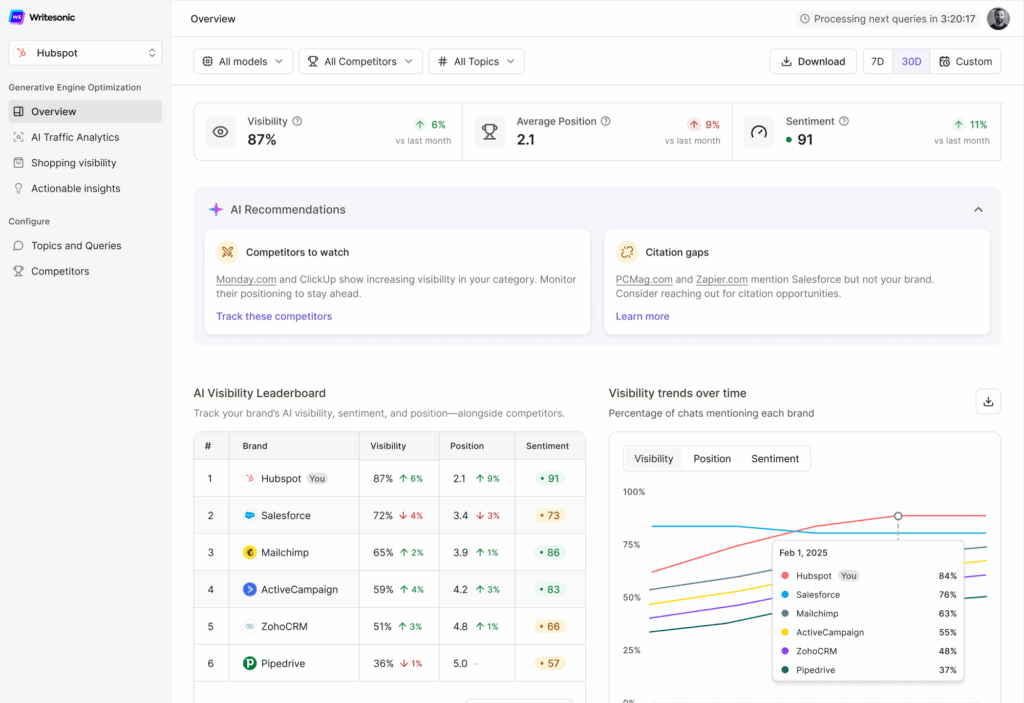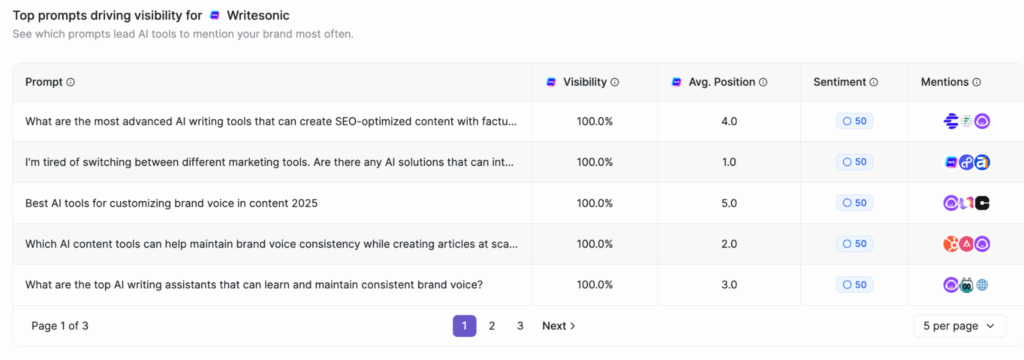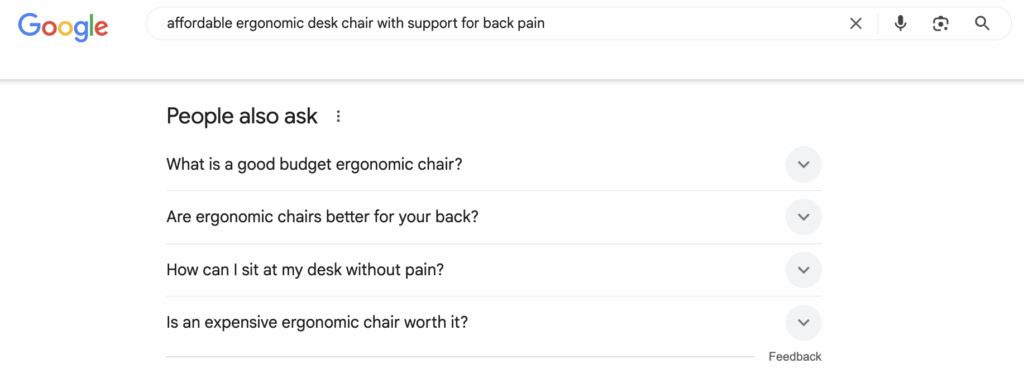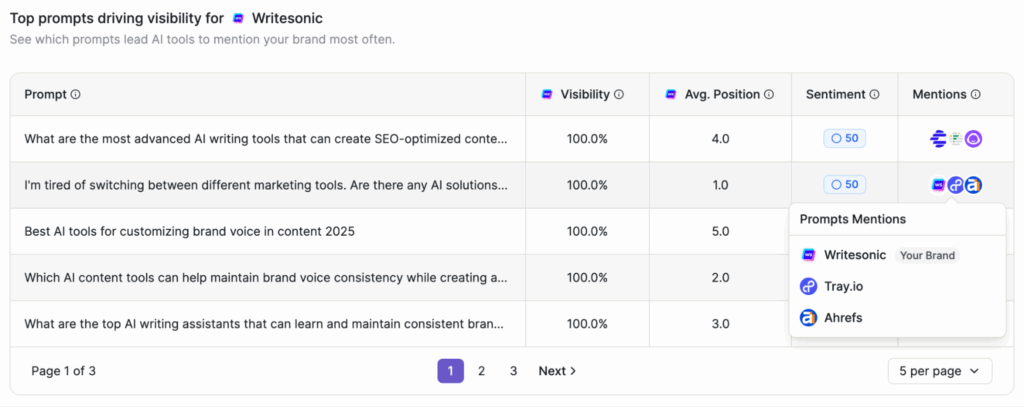If you’re not controlling your brand presence on AI search, you’re not just losing traffic—you’re losing visibility where it matters most.
AI search engines like ChatGPT, Google’s AI Overviews, Perplexity, and Claude are reshaping how people search, serving answers directly, often without linking back to your site.
This guide will show you how to take control inside the platforms driving the future of search.
How AI search is changing brand visibility
AI search engines like ChatGPT and Google’s AI Overviews are replacing traditional search behavior by serving curated, direct answers.
That means if your brand isn’t being pulled into those answers, it’s being skipped, no matter how high you rank in Google’s blue links.
1. Traditional SEO is no longer enough
Most SEO strategies today still focus on things like keyword optimization, metadata, alt text, and site speed. These tactics are good for ranking on Google, but getting your content to appear in AI search engines doesn’t work the same way.
Instead, generative engine optimization is changing the way content gets seen across the web. Since AI search doesn’t return a list of links as found on traditional SERPs, large language models prefer one concise, authoritative response, often without even showing the source.
And here’s why this is affecting traditional SEO:
- 65% of Google searches now result in zero clicks.
- Gartner predicts search engine volume will drop 25% by 2026, due to AI chatbots and virtual agents.
- And 30% of all queries will be answered by AI directly by 2026.
In other words, fewer people are using search in the traditional way, and even fewer are clicking through. You might have strong SEO, but if you’re not showing up in AI answers, you’re invisible where it counts.
2. How AI search engines generate responses
AI systems don’t rely on keyword matching like Google did for years. Instead, they:
- Parse full questions using natural language
- Pull data from multiple sources at once
- Weigh authority, clarity, and structure, not just backlink volume
Google’s AI Overviews blend information from:
- Knowledge Graph
- Product listings
- Shopping feeds
- Real-time web sources
- Authoritative blogs and support content
Other platforms like ChatGPT and Perplexity use live web crawling to build summarized responses from multiple domains. If your content lacks structure or context, it’s not likely to get cited.
In short, content creators need to ensure that they are optimizing for AI search engines by understanding exactly how they cite content from the web.
3. The rise of conversational and intent-based queries
People don’t search like they used to. Instead of typing short phrases like “CRM for recruiters,” they now ask full, specific questions like:
“What’s the best CRM for a small recruiting agency that doesn’t have a tech team?”
This change is happening because of how we interact with AI tools and voice assistants. We speak to them like we speak to people, and they’re trained to respond the same way.
Here’s what’s driving the shift:
- There are now more voice assistant devices than humans on the planet (Statista, 2024).
- 58% of users rely on voice search to find local businesses.
- 52% of Google searches are informational, meaning users are just looking for answers, not to click a link or buy something.
AI search tools like ChatGPT and Google’s AI Overviews are built to understand natural, intent-driven language. So if your content doesn’t clearly answer questions in simple and direct language, AI is likely to skip it, no matter how optimized it is for traditional SEO.
💡Also learn about: ChatGPT Impact on Google Search Traffic
How Writesonic’s Generative Engine Optimization tool tracks AI traffic
You can’t track your AI brand management if you don’t know what AI sees—and that’s exactly the blind spot Writesonic fixes.
Writesonic’s Generative Engine Optimization (GEO) tool shows you how often platforms like ChatGPT, Gemini, Claude, and Perplexity visit your site, what they crawl, and which pages they keep coming back to.

It’s server-side tracking, so you’re not relying on incomplete bot data from Google Analytics. You’re seeing the real footprint AI systems leave behind.
You can also track which prompts across AI search engines are triggering mentions of your brand.
For example, if users ask “What’s the best AI content tool for brand consistency?”, you’ll see if your brand was part of that answer—and how often.

That means you’re not just measuring visibility, you’re understanding why you’re visible.
With Writesonic’s GEO tool, you also get:
- A breakdown of your top-crawled pages.
- Insights into citation sources AI pulls from.
- Competitor comparisons to see who’s gaining ground in AI results.
- Which platforms (e.g. ChatGPT vs. Gemini) are showing the most activity.
- Sentiment and visibility scores of your brand across different AI search engines.
Setup takes minutes, with zero code and zero impact on site performance.
So if you want a baseline and solid metrics to kickstart your brand presence strategy on AI search, this is the tool you need.
Controlling your brand presence on AI search: 7 strategies
You need to go beyond traditional SEO to control your brand presence on AI search. AI platforms like ChatGPT, Google AI Overviews, and Perplexity surface answers—not links—based on clarity, structure, and relevance.
That means your content must speak the language of AI: answering real questions in natural language, using clean formatting, schema markup, and intent-focused messaging.
It’s also critical to track how AI engines engage with your site using tools like Writesonic’s GEO or AI Traffic Analytics feature, so you know what’s getting seen—and why.
In the sections below, we’ll break down exactly how to do this across content optimization, long-tail queries, voice search, backlinking, and more. Here’s where to start:
1. Optimize your content for AI search behavior
Creating content optimized for AI search requires understanding the specific ways these systems process and evaluate information. Unlike traditional search engine optimization that focuses primarily on SEO keywords, AI search engines analyze content comprehensively for context, relevance, and authority.
Therefore, your content should focus on comprehensive topical coverage rather than keyword density. AI systems prefer content that thoroughly addresses a subject with appropriate depth. So, make sure you structure your content logically with clear headings and subheadings that follow a natural information hierarchy.
This organization helps AI crawlers understand and categorize your content more effectively.
AI systems prioritize content that provides direct answers to user queries. Format your key information in such a way:
- Question-answer pairs that directly address common queries.
- Concise definitions at the beginning of sections.
- Factual statements supported by relevant data.
- Structured lists that break down complex processes.
Use straightforward language, appropriate heading structures, and descriptive meta descriptions. Break up lengthy text into scannable paragraphs with appropriate white space.
Most importantly, never sacrifice content quality. AI systems increasingly evaluate content based on expertise, authoritativeness, and trustworthiness factors.
💡Pro tip: Writesonic’s AI Traffic Analytics tool provides valuable insight into how AI crawlers interact with your content. By identifying which pages and topics receive the most AI attention, you can discover patterns in the content formats and structures that appeal to these systems.
Given these patterns, you can then optimize future content based on what demonstrably works.
Keep in mind that AI search engines prioritize freshness differently than traditional search. They tend to favor recently updated, current information, especially for topics that evolve quickly.
Therefore, establish a regular content audit schedule to ensure your material remains accurate and up-to-date.
2. Optimize for long-tail queries and FAQ structures
Long-tail queries are precise, specific search phrases that, despite lower individual search volume, collectively drive substantial traffic and yield higher conversion rates.
More importantly, as AI search becomes more conversational, users now form queries as complete questions or detailed phrases rather than disjointed keywords. This shift creates excellent opportunities for brand visibility through long-tail keyword optimization.
For example, a query like “affordable ergonomic desk chair with support for back pain” carries much clearer intent than simply “affordable office chair.”
To capture these detailed queries effectively, structure your content around natural language patterns. Identify common questions in your niche using tools like Answer the Public or Google’s People Also Answer boxes.

Then create comprehensive answers using clear, straightforward language.
FAQ sections are particularly valuable for AI visibility because they match the question-answer format that AI systems frequently use when responding to users.
Format these sections with:
- Clear, direct questions using natural language
- Concise yet thorough answers (100-200 words each)
- Semantic HTML markup (using
andtags)
- FAQ schema implementation to enhance AI understanding
💡 Pro tip: When creating FAQ content, focus on questions your customers actually ask rather than what you think they might ask. Customer service teams and sales calls are excellent sources for authentic question ideas.
Here are some more ways to optimize for long-tail queries and question-based content:
- Identify question clusters around core topics
- Create dedicated pages for complex long-tail queries
- Implement proper heading hierarchies (H2, H3, H4) that follow conversational patterns
3. Focus on search intent rather than keywords
AI search doesn’t reward keyword density—it rewards usefulness.
Large language models like ChatGPT and Gemini are trained to respond to why someone is asking a question, not just what they typed.
That means ranking for AI-generated responses like featured snippets and AI overviews has less to do with SEO keyword optimization and more to do with whether your content fully satisfies the search intent behind the prompt.
As a result, if you have content that is ranking well in Google SERPs, it doesn’t automatically get a visibility boost in AI search engines.
Here’s where most brands get it wrong: they chase volume keywords without understanding the actual search intent behind those phrases.
Let’s say someone enters this prompt into ChatGPT:
“Which CRM is best for managing high-volume candidate outreach?”
If your content doesn’t directly answer the question—including features, edge cases, and trade-offs—you’ll be outranked by a smaller brand that does.
This is where Writesonic’s GEO tool gives you an edge. It doesn’t just show you AI traffic—it shows which prompts are triggering visibility, what the user is actually trying to solve, and how your competitors are showing up differently.

With that data, you can:
- Rework content to match the top-performing intent categories.
- Identify “search intent gaps” in high-volume prompts that mention your competitors but not you.
- Track how sentiment and position shift when content better aligns with task-based queries.
Bottom line: Keyword targeting gets you rankings. Optimizing for search intent gets you cited by AI.
4. Use of schema markup and structured data
AI search engines rely on structured data to quickly understand what a page is about. Schema markup helps them identify the type of content—whether it’s a product, guide, FAQ, or review—and extract the right information to include in answers.
Without structured data, your content may not get indexed correctly or cited at all.
To improve brand visibility for AI:
- Use FAQPage, HowTo, Product, and Organization schema where applicable.
- Add Breadcrumb and Article schema to give AI better context on content hierarchy.
- Make sure your schema accurately reflects on-page content—don’t add markup for things that aren’t visible.
Structured data isn’t just for SEO anymore—it’s a signal that tells AI your content is reliable, relevant, and easy to parse. That can directly influence whether your brand appears in AI-generated answers.
The most beneficial schema types for AI visibility include:
- Product schema: Enhances product pages with pricing, availability, and reviews.
- FAQ schema: Helps AI generate direct answers from your content.
- Article schema: Clarifies authorship, publish date, and content type.
- LocalBusiness schema: Crucial for location-based queries.
- Organization schema: Defines your brand identity and relationships.
Properly implemented schema creates a connected knowledge graph rather than isolated data points. This connected approach helps AI systems understand relationships between entities on your site.
💡Also learn about: Google AI Mode and How It Affects Your Traffic
5. Build strategic partnerships and backlinks
In AI-driven search, credibility isn’t just about your content—it’s about who references you. AI models prioritize information from authoritative sources.
Therefore, securing backlinks from reputable sites signals trustworthiness and can enhance your visibility in AI-generated responses.
Effective partnership strategies for optimizing for AI search engines include:
- Guest contributions: Write articles for respected industry publications. Ensure your content provides value and includes a link back to your site.
- Expert commentary: Offer insights to journalists and bloggers. Being quoted in authoritative articles can lead to valuable backlinks.
- Collaborative content: Partner with other reputable brands to create joint studies or reports. Such collaborations often result in mutual backlinks.
- Resource listings: Get your tools or content featured in curated lists or directories relevant to your industry.
Key considerations:
- Relevance: Ensure backlinks come from sites related to your industry or niche.
- Authority: Aim for links from sites with high domain authority.
- Natural integration: Backlinks should be contextually integrated into the content, not forced or out of place.
By focusing on genuine, high-quality link building, you enhance your site’s authority, making it more likely for AI search engines to recognize and reference your content.
You can also consider guest blogging opportunities on reputable industry sites, which creates mutual value through knowledge exchange and exposure to new audiences.
HARO (Help a Reporter Out) is also a great platform to connect with journalists seeking expert insights, potentially earning citations in major publications.
💡 Pro tip: Claim unlinked brand mentions by setting up Google Alerts and requesting link additions when your brand appears without proper attribution.
6. Optimize for voice search and conversational queries
Did you know that 50% of voice search results rely on a featured snippet to provide users with information? This means that if AI is not citing your content for Google featured snippets, chances are, it won’t get picked up by voice assistants like Siri and Alexa.
Unlike traditional keyword fragments, voice searches typically use complete sentences, conversational language, and natural speech patterns. For example, instead of typing “veggie burger recipe,” a user might ask, “What’s the best recipe for a veggie burger?”
This distinction necessitates adapting your content accordingly.
To optimize effectively for voice search:
- Structure content around questions: Create FAQ sections that directly answer common voice queries with concise, straightforward responses (100-200 words each).
- Use conversational keywords: Incorporate natural language patterns and complete sentences rather than keyword fragments. Analyze your target audience’s speech patterns—different generations use voice search differently.
- Prioritize local keyword research: Approximately 50% of voice searches have local intent. Keep your business information consistent across all platforms, as voice assistants often pull from Google Business Profiles for local queries.
- Aim for featured snippets: Voice assistants frequently pull answers from these prominent positions. Format responses clearly and concisely to increase your chances of selection.
By implementing these voice-centric approaches, you’ll enhance your brand’s presence across the growing ecosystem of AI-powered voice assistants.
7. Monitor trends, sentiment, and brand mentions using Writesonic
Writesonic’s GEO tool offers a suite of features to help you track and optimize for AI brand management. Start by ensuring you conduct regular audits to monitor your brand visibility on AI search engines:
- Weekly checks: Monitor immediate brand mentions and sentiment changes to stay ahead of emerging trends.
- Monthly reviews: Conduct in-depth analyses to assess your content strategies’ effectiveness and identify areas for improvement.
During these audits, make sure you keep track of these key AI visibility metrics:
- Brand presence: Track how often and in what context your brand appears in AI-generated responses across platforms like ChatGPT, Google AI Overviews, Claude, and Perplexity.
- Sentiment analysis: Gauge the tone of AI mentions—positive, neutral, or negative—to understand public perception and adjust your messaging accordingly.
- Trend monitoring: Observe how your brand’s visibility changes over time, helping you adapt your strategies to align with current trends.
- Competitor benchmarking: Compare your brand’s AI visibility against competitors to identify gaps and opportunities for differentiation.
- Top prompts driving visibility: Compare topic-wise visibility and detailed prompts to understand exactly what is getting cited and what you should optimize your content for.
With clear insights from these metrics, you can create action steps for optimizing for AI search engines:
- Content optimization: If certain topics or keywords are associated with negative sentiment, revise your content to address concerns and improve perception.
- Strategic outreach: For areas where your brand is underrepresented, consider partnerships or content collaborations to enhance visibility.
- Prompt performance tracking: Identify which prompts are triggering mentions of your brand and tailor your content to align with these queries.
Staying visible in AI search isn’t a one-time fix. It’s something you need to track, audit, and improve consistently. If you want to actually see how AI platforms are picking up your brand—and not just guess—Writesonic’s Generative Engine Optimization tool gives you that view.
Real-time AI crawler data, prompt-level insights, and visibility trends in one place. Start tracking your AI visibility now!
FAQs
1. How does AI search differ from traditional search engines?
AI search uses advanced natural language processing to understand context and intent, providing direct answers rather than just links. It focuses on comprehensive topic coverage and conversational queries, making traditional keyword optimization less effective.
2. What are the key factors influencing brand visibility in AI search?
The main factors are topical authority and expertise, mentions in high-authority sources, and content freshness. AI systems prioritize brands that consistently demonstrate deep knowledge in specific subjects and are frequently cited by reputable sources.
3. How can I optimize my content for AI search engines?
Focus on creating comprehensive, well-structured content that thoroughly addresses topics. Use clear headings, implement schema markup, and format information in easily digestible ways like FAQs and lists. Regularly update your content to maintain relevance.
4. Why is tracking AI crawler activity important?
Monitoring AI crawler activity reveals which content AI systems value most, often differing from human preferences. This insight allows you to optimize specifically for AI visibility and adapt your content strategy based on actual AI behavior.
5. How can voice search optimization improve AI visibility?
Optimizing for voice search involves structuring content around natural language questions, using conversational keywords, and focusing on local intent. This approach aligns with how AI systems process and prioritize information for voice-based queries.

















